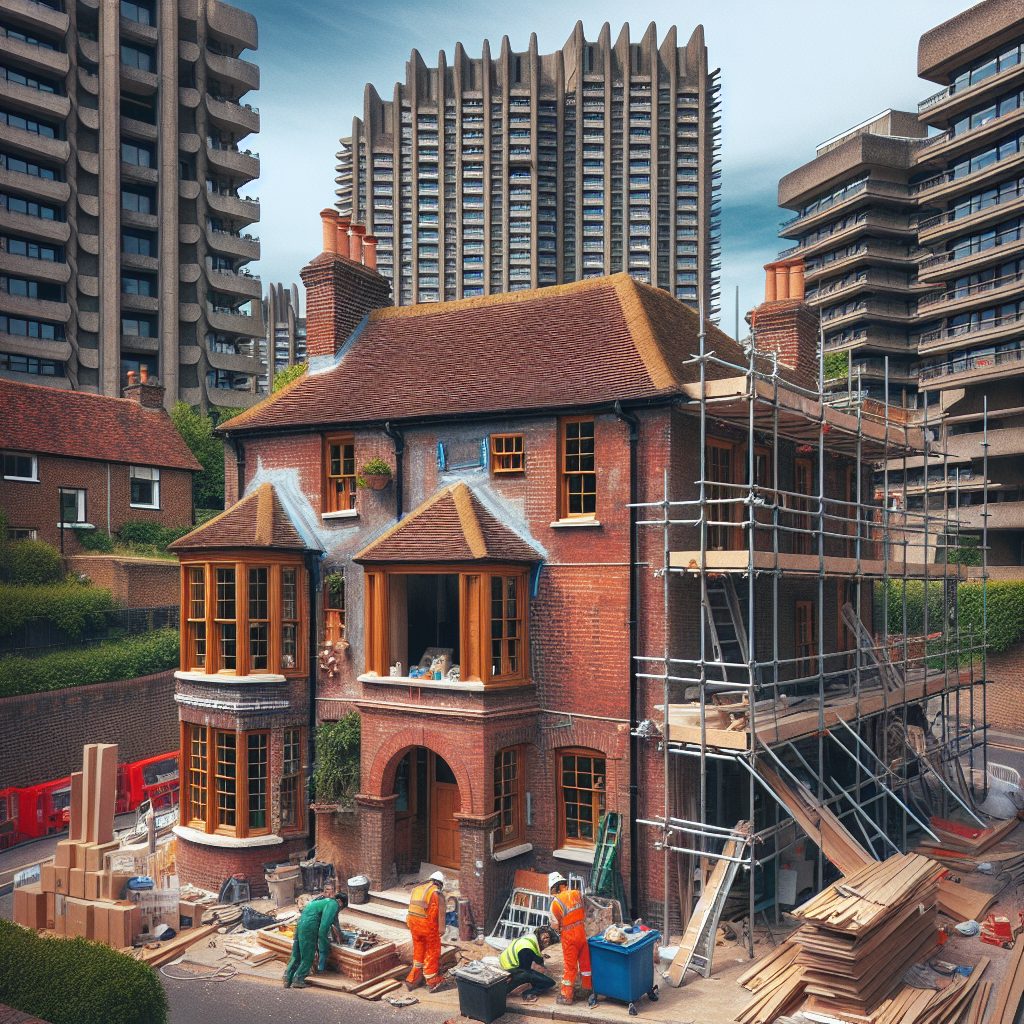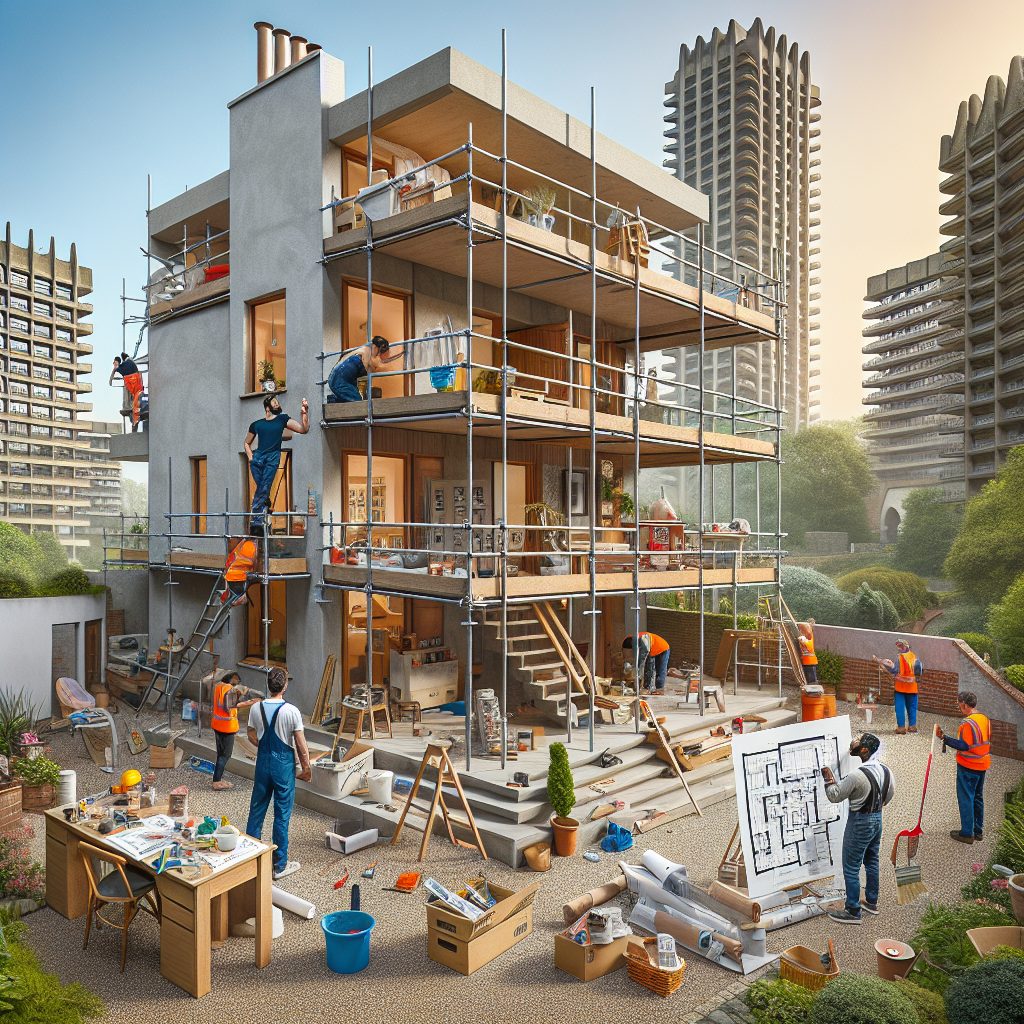Innovative House Renovation Ideas in Barbican
In the heart of London, the Barbican district is renowned for its unique blend of historical and contemporary architecture. This juxtaposition of old and new provides a fertile ground for innovative house renovation ideas. As homeowners seek to preserve the historical charm of their properties while incorporating modern conveniences, they are turning to cutting-edge design and construction techniques to achieve their goals.
One of the most popular trends in house renovation in Barbican is the fusion of traditional and contemporary design elements. This approach allows homeowners to maintain the historical integrity of their properties while introducing modern aesthetics and functionality. For instance, original brickwork and wooden beams can be preserved and highlighted, while sleek, minimalist furniture and fixtures can be added to create a striking contrast. This juxtaposition of old and new not only enhances the visual appeal of the property but also adds a unique character that sets it apart from conventional homes.
Another innovative idea that is gaining traction in Barbican is the incorporation of sustainable and energy-efficient features in house renovations. With growing awareness about environmental issues, homeowners are increasingly seeking ways to reduce their carbon footprint and make their homes more energy-efficient. This can be achieved through various means, such as installing solar panels, using energy-efficient appliances, and incorporating insulation and ventilation systems that reduce energy consumption. Additionally, the use of sustainable materials in renovations, such as reclaimed wood and recycled metal, not only contributes to environmental conservation but also adds a unique, rustic charm to the property.
Space optimization is another key aspect of house renovation in Barbican. Given the premium on space in this densely populated district, homeowners are constantly seeking innovative ways to maximize their living area. This can be achieved through clever design solutions such as multi-functional furniture, built-in storage, and open-plan layouts that create an illusion of space. Additionally, the use of glass and mirrors can also help to enhance the sense of space by reflecting light and creating a brighter, more open feel.
The integration of smart home technology is another trend that is reshaping the landscape of house renovation in Barbican. With advancements in technology, homeowners can now control various aspects of their homes, such as lighting, heating, and security, through their smartphones or tablets. This not only enhances convenience and comfort but also improves energy efficiency and security. Moreover, the seamless integration of this technology into the design of the home can add a modern, futuristic touch to the property.
In conclusion, house renovation in Barbican is not just about improving the aesthetic appeal of a property. It is about creating a home that is comfortable, functional, and sustainable, while preserving its historical charm. Whether it is through the fusion of traditional and contemporary design elements, the incorporation of sustainable features, the optimization of space, or the integration of smart home technology, homeowners in Barbican are constantly pushing the boundaries of innovation in their quest to create their dream homes.
The Ultimate Guide to Barbican House Renovation

Renovating a house in Barbican, a residential area in London known for its iconic Brutalist architecture, requires a deep understanding of the area’s unique architectural style and strict planning regulations. This article provides a comprehensive guide to navigating the complexities of house renovation in Barbican, ensuring that your project is successful and compliant with local regulations.
The first step in any renovation project is to understand the architectural style of the area. Barbican is renowned for its Brutalist architecture, a style characterized by its raw, unadorned use of concrete and its emphasis on function over form. This style is reflected in the Barbican Estate, a residential complex that is a prime example of Brutalist architecture. Therefore, any renovation project in Barbican should respect and enhance this unique architectural style.
Understanding the planning regulations in Barbican is also crucial. The Barbican Estate is a Grade II listed building, which means that any alterations to the exterior of the buildings require planning permission from the City of London Corporation. This includes changes to windows, doors, and even the colour of the paint. Therefore, before starting your renovation project, it is essential to consult with the local planning authority to ensure that your plans are compliant with these regulations.
In addition to planning regulations, there are also building regulations to consider. These regulations cover aspects such as structural safety, fire safety, energy efficiency, and accessibility. For example, if your renovation project involves structural changes, you will need to ensure that the building can safely support these changes. Similarly, if you are planning to add or alter windows, you will need to ensure that they meet energy efficiency standards. Therefore, it is advisable to work with a qualified architect or builder who is familiar with these regulations.
When planning your renovation project, it is also important to consider the practicalities of living in Barbican. The area is known for its high-density living, with many flats and apartments. Therefore, any renovation project should aim to maximize the use of space. This could involve clever storage solutions, multi-functional furniture, or open-plan living areas. Additionally, due to the area’s urban location, noise and privacy can be issues. Therefore, soundproofing and privacy measures should also be considered.
Finally, it is important to consider the cost of your renovation project. Renovating a house in Barbican can be expensive, due to the area’s high property prices and the cost of materials and labour. Therefore, it is important to budget carefully and consider the potential return on investment. This could involve researching property prices in the area, considering the added value of your proposed changes, and seeking professional advice on the most cost-effective solutions.
In conclusion, renovating a house in Barbican requires a careful consideration of the area’s unique architectural style, strict planning and building regulations, practical living considerations, and cost. By understanding these factors and planning carefully, you can ensure that your renovation project is successful, compliant, and adds value to your property.
Cost-effective Strategies for House Renovation in Barbican
House renovation in Barbican, a residential area in London known for its iconic brutalist architecture, can be a daunting task. However, with the right strategies, it can be a cost-effective and rewarding endeavour. This article will explore several cost-effective strategies for house renovation in Barbican, focusing on planning, materials, labour, and energy efficiency.
Firstly, planning is a crucial aspect of any renovation project. A well-thought-out plan can help homeowners avoid costly mistakes and ensure that the renovation stays within budget. It is advisable to start by identifying the areas that need renovation and prioritising them based on necessity and budget. For instance, if the kitchen is outdated but the bathroom is in a dire state, it would be more cost-effective to renovate the bathroom first. Additionally, homeowners should consider the long-term costs and benefits of their renovation decisions. For example, investing in high-quality materials may be more expensive initially, but it can save money in the long run by reducing maintenance and replacement costs.
Secondly, the choice of materials can significantly impact the cost of a renovation. Homeowners can save money by choosing materials that are durable, easy to maintain, and reasonably priced. For instance, laminate flooring is a cost-effective alternative to hardwood flooring. It is less expensive, easier to install, and requires less maintenance. Furthermore, homeowners can save money by repurposing or refurbishing existing materials. For example, old kitchen cabinets can be repainted or refaced instead of being replaced, which can significantly reduce renovation costs.
Labour is another significant cost factor in house renovations. Homeowners can save money by doing some of the work themselves. However, it is important to be realistic about one’s skills and time constraints. Tasks like painting and minor repairs can be done by homeowners, but more complex tasks like plumbing and electrical work should be left to professionals. Hiring a professional may be more expensive initially, but it can save money in the long run by ensuring that the job is done correctly and safely.
Lastly, energy efficiency should be a key consideration in any house renovation in Barbican. Incorporating energy-efficient features can significantly reduce long-term costs. For instance, installing energy-efficient appliances, insulation, and windows can reduce energy consumption and lower utility bills. Additionally, some energy-efficient renovations may qualify for government grants or tax credits, which can offset some of the renovation costs.
In conclusion, house renovation in Barbican can be a cost-effective endeavour with the right strategies. A well-thought-out plan, careful selection of materials, judicious use of labour, and a focus on energy efficiency can help homeowners renovate their houses without breaking the bank. However, it is important to remember that every house and every renovation project is unique. Therefore, homeowners should consider their specific circumstances and consult with professionals before making any major renovation decisions.

